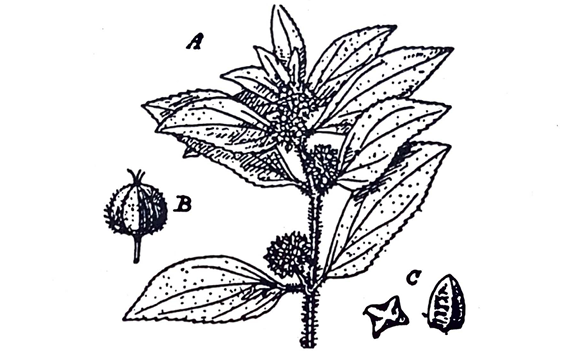Synonyms
Euphorbia Pilulifera, Euphorbia Pilulifera, Herba Euphorbiae, Euphorbia Herba Euphorbia
Botanical source of Euphorbia Hirta
Euphorbia Hirta consists of the dried aerial parts of flowering and fruiting Euphorbia hirta Linn., an annual, low, almost creeping herb of family Euphorbiaceae.
Geographical source
The plant grows wild as a weed in many tropical countries including Nigeria, Bangladesh, and India.
Macroscopical and microscopical characters
The drug consists of the matted aerial stems, leaves, inflorescence and fruits of the plant. Steams are slender, the upper young parts of which are hispid with yellow spreading hairs and pubescent with short curved hairs; the older parts bear reddish purple patches. Leaves are oblong-lanceolate, short-petioled, 2 to 4 cm long with minutely dentate or serrulate margin, dark green in colour, frequently blotched with red. They are hairy on both surfaces and have an opposite arrangement on the stem. The small flowers occur in dense axillary or terminal cymes, about 1 cm in diameter fruits are three-celled minute capsules, about 1 mm in diameter, yellow in colour and each contains a single, reddish, four-sided transversely wrinkled seed.

Fig. 16: Euphorbia Hirta. A, upper part of a flowering stem; B, fruit; C, seeds (Reproduced from Wallis).
Chemical constituents
Euphorbia Hirta contains a number of flavonoids and terpenoids, alkanes, phenolic acids, a poisonous glycoside, an alkaloid, choline, sugars and colouring·matters. It also contains tannins.
Uses of Euphorbia Hirta
The drug, particularly its decoction, is frequently used for the treatment of cough, asthma, bronchitis, hay fever, whooping cough, and other respiratory tract infections. The plant is effective against diarrhoea and amoebic dysentery. It is yet to get full recognition as an official drug in the British or United States pharmacopoeias, although it 1s included 1n the African Pharmacopoeia of 1985.

